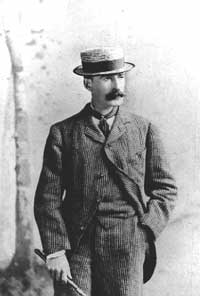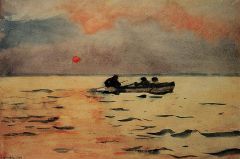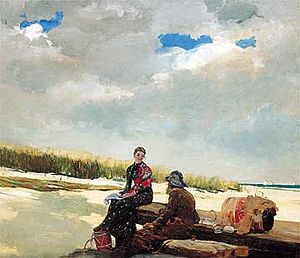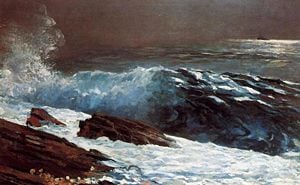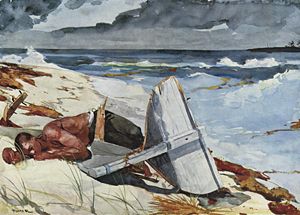Winslow Homer
Winslow Homer (February 24, 1836 – September 29, 1910) was an American landscape painter and printmaker, Largely self-taught, he excelled equally in the arts of illustration, oil painting and watercolor. The broad range of his work encompasses the many places he visited as an artist, from Civil War battlefields to northern England's desolate coast, to the tropical locale of the Caribbean.
Although he is best remembered for his pictures of bucolic scenes from 19th century American farm life, his later work depicts man's often heroic struggle with the forces of nature, particularly the sea. Today, he is considered one of the preeminent figures in American art.
Early life and career
Winslow Homer was born in Boston, Massachusetts, the second of three sons of Henrietta Benson, an amateur watercolorist, and Charles Savage Homer, a hardware importer. At the age of 19, he was apprenticed to a commercial lithographer for two years before becoming a freelance illustrator in 1857. Soon he was a major contributor to such popular magazines as Harper’s Weekly. In 1859 he moved to New York to be closer to the publishers that commissioned his illustrations and to pursue his ambitions as a painter.
His early works, mostly commercial engravings, are characterized by clean outlines, simplified forms, dramatic contrast of light and dark, and lively figure groupings — qualities that remained important throughout his career.
In 1859 he opened a studio in New York City, and began his painting career. Harper's sent Homer to the front lines of the American Civil War (1861 - 1865), where he sketched battle scenes and mundane camp life. His initial sketches were of the camp and army of the famous Union officer, Major General George B. McClellan at the banks of the Potomac River in October, 1861. Although the drawings did not get much attention at the time, they mark Homer's transition from illustrator to painter. Back at his studio after the war, Homer set to work on a series of war-related paintings, among them Sharpshooter on Picket Duty, and Prisoners from the Front, which is noted for its objectivity and realism.
Landscapes and rural scenes
After exhibiting at the National Academy of Design, Homer traveled to Paris, France in 1867 where he remained for a year. He practiced landscape painting while continuing to work for Harper's. Though his interest in depicting natural light parallels that of the impressionists, there is no evidence of direct influence.
Throughout the 1870s he painted mostly rural or idyllic scenes of farm life, children playing, and young adults courting. Homer gained acclaim as a painter in the late 1870s and early 1880s. His 1872 composition, Snap-the-Whip, was exhibited at the 1876 Centennial Exposition in Philadelphia, Pennsylvania.
The same straightforward sensibility which allowed Homer to distill art from these potentially sentimental subjects also yielded the most unaffected views of African American life at the time.[1]
Direct and sustained observation was important to Homer; he once remarked, that "he painted only what he saw." [2]
England
In 1875 Homer quit working as a commercial illustrator. He traveled widely, spending two years (1881 – 1882) in the English coastal village of Cullercoats, Northumberland, where he rekindled his boyhood interest in the sea, and painted the local fishermen. Many of the paintings at Cullercoats took as their subjects young women mending nets or looking out to sea; they are imbued with a solidity, sobriety, and earthy heroism which was new to Homer's art, and they presage the direction of his future work.
Maine and maturity
In 1873 Homer started painting with watercolors. His impact on the medium would be revolutionary.
Back in the United States he moved to Prout's Neck, Maine (in Scarborough) and painted the seascapes for which he is best known and which have not become pictorial classics of the sea. Notable among these dramatic struggle-with-nature images are Banks Fisherman, Eight Bells, The Gulf Stream, Rum Cay, Mending the Nets, and Searchlight, Harbor Entrance, Santiago de Cuba.
It is notable that his most memorable work was not undertaken until after the age of forty-five.
In the winter Homer ventured to warmer locations in Florida, Cuba, and the Bahamas. Additionally he found inspiration in a number of summer trips to the North Woods Club, near the hamlet of Minerva, New York in the Adirondack Mountains. It was on one of these fishing vacations that he experimented freely with the watercolor medium, producing works of both - vigor and subtlety, hymns to solitude. In terms of quality and innovation, Homer's achievements as a watercolorist are unparalleled: "Homer had used his singular vision and manner of painting to create a body of work that has not been matched."[3]
Homer died at the age of 74 in his Prout's Neck studio and was interred in the Mount Auburn Cemetery in Cambridge, Massachusetts. His painting, Shoot the Rapids, remains unfinished.
Legacy
Homer's paintings strongly influenced succeeding generations of American painters with their direct and energetic interpretation of man's stoic relationship to an often neutral and sometimes harsh wilderness (See Lost on the Grand Banks, collection of Bill Gates).
One biographer has called Homer the greatest pictorial poet of outdoor life in 19th-century America. "In his energy, his wide range, the pristine freshness of his vision, and his simple sensuous vitality, he expressed certain aspects of the American spirit as no preceding artist had." [4]
Homer was a member of the 'The Tile Club', a group of artists and writers who met frequently to exchange ideas and organize art outings. Other well known members of the group were painters William Merritt Chase, Arthur Quartley, and the sculptor Augustus Saint Gaudens.
ReferencesISBN links support NWE through referral fees
- "Winslow Homer." Encyclopedia of World Biography, 2nd ed. 17 Vols. Gale Research, 1998.
Reproduced in Biography Resource Center. Farmington Hills, Mich.: Thomson Gale. 2007.
- A Treasury of Art Masterpieces: From the Renaissance to the Present Day, edited by Thomas Craven Simon & Schuster, 1939.
- "Winslow Homer: Poet of the Sea," American Art Review (August 2006)
Notes
- ↑ Updike, John, page 69, 2005. "Among his feats may be listed the best, least caricatural portraits of postbellum African Americans."
- ↑ "A Treasury of Art Masterpieces: From the Renaissance to the Present Day," edited by Thomas Craven Simon & Schuster, 1939.
- ↑ Walsh, Judith: "Innovation in Homer's Late Watercolors," Winslow Homer, page 283. National Gallery of Art, 1995.
- ↑ "Winslow Homer." Encyclopedia of World Biography, 2nd ed. 17 Vols. Gale Research, 1998. Reproduced in Biography Resource Center. Farmington Hills, Mich.: Thomson Gale. 2007.
External links
- "Winslow Homer", National Gallery of Art, Retrieved July 24, 2007.
- "Winslow Homer Gallery", White Mountain Art and Artists, Retrieved July 24, 2007.
- "Winslow Homer Artwork Examples", AskART, Retrieved July 24, 2007.
- "Winslow Homer : Making Art, Making History", The Clark, Retrieved July 24, 2007.
- Weinberg, Barbara H., Timeline of Art History, 2000; "Winslow Homer: 1836-1910", The Metropolitan Museum of Art, Retrieved July 24, 2007.
Credits
New World Encyclopedia writers and editors rewrote and completed the Wikipedia article in accordance with New World Encyclopedia standards. This article abides by terms of the Creative Commons CC-by-sa 3.0 License (CC-by-sa), which may be used and disseminated with proper attribution. Credit is due under the terms of this license that can reference both the New World Encyclopedia contributors and the selfless volunteer contributors of the Wikimedia Foundation. To cite this article click here for a list of acceptable citing formats.The history of earlier contributions by wikipedians is accessible to researchers here:
The history of this article since it was imported to New World Encyclopedia:
Note: Some restrictions may apply to use of individual images which are separately licensed.
